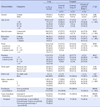Abstract
Purpose
This study was conducted to identify the effects of organizational health and patient safety culture on nursing activities for patient safety as perceived by hospital nurses.
Methods
A self-report survey was administered to staff nurses of one advanced general hospital and two general hospitals in South Korea. Of the questionnaires, 188 were analyzed.
Figures and Tables
Table 2
Perception of Organizational Health, Patient Safety Culture, Patient Safety Nursing Activities (N=188)

Table 3
Differences of Perceived Organizational Health, Patient Safety Culture, Patient Safety Nursing Activities (N=188)

References
1. Kim EK, Kim YM, Park SH, Choi YK, Hwang JH. Quality management in health care organization. 1st ed. Seoul: Koonja;2014. p. 90–132.
2. Kim MR. Concept analysis of patient safety. J Korean Acad Nurs. 2011; 41(1):1–8. DOI: 10.4040/jkan.2011.41.1.1.
3. Kim JE, Kang MA, An KE, Sung YH. A survey of nurses' perception of patient safety related to hospital culture and reports of medical errors. J Korean Clin Nurs Res. 2007; 13(3):169–179.
4. Sorra J, Gray L, Streagle S, Famolaro T, Yount N, Behm J. AHRQ hospital survey on patient safety culture: user's guide.(Prepared by Westat, under Contract No. HHSA290201300003C). AHRQ Publication No. 15-0049-EF(Replaces 04-0041) [Internet]. Rockville, MD: Agency for Healthcare Research and Quality;updated January 2016. cited 2016 June 2. Available from: http://www.ahrq.gov/sites/default/files/wysiwyg/professionals/quality-patient-safety/patientsafetyculture/hospital/resources/hospcult.pdf.
5. Meterko M, Mohr DC, Young GJ. Teamwork culture and patient satisfaction in hospitals. Med Care. 2004; 42(5):492–498. DOI: 10.1097/01.mlr.0000124389.58422.b2.
6. Kim YL, Lee MH. Perceptions of patient safety culture of hospital nurses. J Saf Crisis Manag. 2015; 11(1):83–99.
7. Choi JH, Lee KM, Lee MA. Relationship between hospital nurses' perceived patient safety culture and their safety care activities. J Korean Acad Fundam Nurs. 2010; 17(1):64–72.
8. Park SJ, Kang JY, Lee YO. A study on hospital nurses' perception of patient safety culture and safety care activity. J Korean Crit Care Nurs. 2012; 5(1):44–55.
9. Kim KJ, Oh EG. Nurses' Knowledge and attitude about incidence reporting according to nursing organizational culture and organizational characteristics. J Korean Acad Nurs Adm. 2009; 15(4):581–592.
10. Davenport DL, Henderson WG, Mosca CL, Khuri SF, Mentzer RM Jr. Risk-adjusted morbidity in teaching hospitals correlates with reported levels of communication and collaboration on surgical teams but not with scale measures of teamwork climate, safety climate, or working conditions. J Am Coll Surg. 2007; 205(6):778–784. DOI: 10.1016/j.jamcollsurg.2007.07.039.
11. Zohar D, Livne Y, Tenne-Gazit O, Admi H, Donchin Y. Healthcare climate: a framework for measuring and improving patient safety. Crit Care Med. 2007; 35(5):1312–1317. DOI: 10.1097/01.ccm.0000262404.10203.c9.
12. Halpin AW. Change and organizational climate. J Educ Adm. 1967; 5(1):5–25. DOI: 10.1108/eb009606.
13. Min J. An analysis on the conception and re-conceptualization of “Organizational Health”. Korean J Public Adm. 2009; 47(2):31–59.
14. Kim JE. A study on the construct validation of measurement for organizational health [dissertation]. Seoul: Hanyang University;2012.
15. Wilson BRA, Wagner DI. Developing organizational health at the worksite. Am J Health Stud. 1997; 13(2):105–108.
16. Ha NS. The relationship between the head nurse's decision making style perceived by nurses and job satisfaction, role conflict and the organizational health in nurses. Korean J Stress Res. 2013; 21(1):61–71.
17. Cho SS, Gang MH. Perception of patient safety culture and safety care activity of entry-level nurses. Korean J Occup Health Nurs. 2013; 22(1):24–34. DOI: 10.5807/kjohn.2013.22.1.24.
18. Gong HH, Son YJ. Impact of nurses' job satisfaction and organizational commitment on patient safety management activities in tertiary hospitals. J Korean Acad Fundam Nurs. 2012; 19(4):453–450. DOI: 10.7739/jkafn.2012.19.4.453.
19. Kizer KW. Large system change and a culture of safety. In : Proceedings of enhancing patient safety and reducing errors in health care; 1998 November 8-10; Rancho Mirage Annenberg Center. California: Chicago, Ill: National Patient Safety Foundation;1999. p. 31–33.
20. Korea Institute for Healthcare Accreditation. Acute hospital healthcare accreditation standards (Ver 2.0) [Internet]. Seoul: Ministry of Health and Welfare;KOIHA;2014. cited 2015 July 1. Available from: http://www.koiha.or.kr.
21. Lee GH. The effects of organizational culture and middle manager leadership on organizational health and the mediating effects of self-efficacy [dissertation]. Busan: Kosin University;2015.
22. Nam MH, Lim JH. The influences of the awareness of patient safety culture on safety care activities among nurse in small-medium sized general hospitals. J Digit Converg. 2013; 11(1):349–359.
23. Nam MH, Kang SH. The cognition level on the patient safety and safe nursing activities among hospital nurses in Busan. Health Soc Sci. 2010; 28:197–221.
24. Kim HY, Kim HS. Effects of perceived patient safety culture on safety nursing activities in the general hospital nurse's. J Korean Acad Nurs Adm. 2011; 17(4):413–422. DOI: 10.11111/jkana.2011.17.4.413.
25. Woo JS, Kim YH, Yoon BJ, Lee HJ, Kim HS, Choi YJ, et al. The effects of accreditation program to the leadership, organizational culture, hospital management activities and performances: focused on perception of accredited hospital professions. Korean J Hosp Manag. 2013; 18(2):33–56.




 PDF
PDF ePub
ePub Citation
Citation Print
Print





 XML Download
XML Download